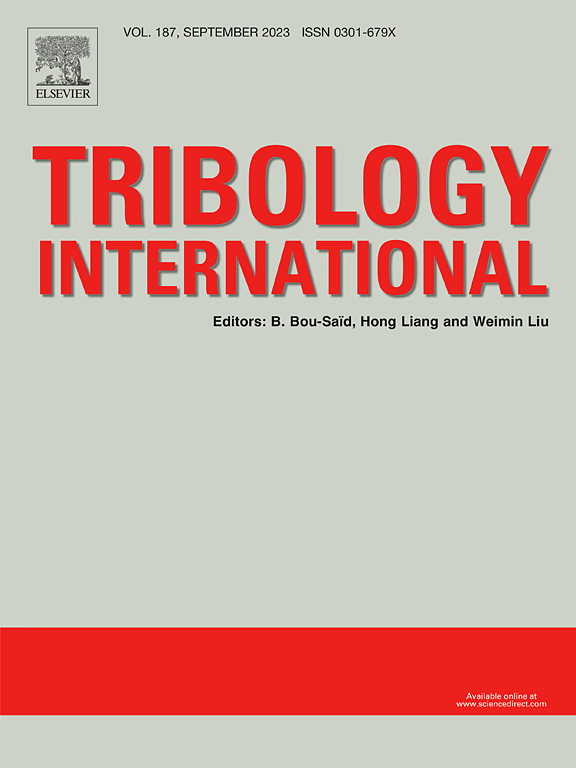Achieving considerable wear resistance in new Ti-based high-entropy alloys through microstructural hardening by adding Nb
IF 6.1
1区 工程技术
Q1 ENGINEERING, MECHANICAL
引用次数: 0
Abstract
In this study, (CoCrNiMn)78Ti22−xNbx eutectic high-entropy alloys were successfully synthesised via an arc melting process under vacuum, and the phase structure, microstructure, mechanical properties and dry sliding tribological behaviour of the alloys were systematically investigated. The XRD results for the (CoCrNiMn)78Ti22−xNbx eutectic high-entropy alloys are almost in agreement with the JMatPro phase diagram simulations, and the volume fraction of the Laves phase increased with increasing Nb content. OM and SEM images revealed that the microstructure was composed of dendrites (BCC A2) and interdendrites (BCC B2 +Laves) and changed from a hypoeutectic to a eutectic to a BCC B2 +Laves dual-phase structure, with the average grain size decreasing from 6.715 µm to 6.391 µm. Ti promoted the growth of the layered Laves phase and provided the alloy with base hardness and wear resistance. The hardness of the alloy combination of 21 % Ti and 1 % Nb reached the maximum value of 707.04 HV, whereas the average coefficient of friction (COF) and wear rate reached the lowest values of 0.49 and 1.668 × 10−4 mm3/N·m, respectively. With increasing load, the wear mechanism was mixed fatigue, delamination wear, and abrasive wear accompanied by oxidation, and the possibility of three-body wear paths between compacted tribolayers cannot be excluded. The debris was mostly in the form of microclusters, and the particle size range was concentrated between 1 −2 µm; meanwhile, the shape of the debris tended to develop from lamellar to spherical with increasing hardness.
通过添加 Nb 进行微结构硬化,在新型钛基高熵合金中实现可观的耐磨性
本研究通过真空电弧熔炼工艺成功合成了(CoCrNiMn)78Ti22-xNbx 共晶高熵合金,并系统研究了合金的相结构、显微组织、力学性能和干滑动摩擦行为。(CoCrNiMn)78Ti22-xNbx 共晶高熵合金的 XRD 结果与 JMatPro 相图模拟结果基本一致,并且随着 Nb 含量的增加,Laves 相的体积分数也在增加。OM 和 SEM 图像显示,微观结构由树枝状晶(BCC A2)和树枝间晶(BCC B2 +Laves)组成,从低共晶到共晶再到 BCC B2 +Laves 双相结构,平均晶粒尺寸从 6.715 µm 减小到 6.391 µm。钛促进了层状 Laves 相的生长,并为合金提供了基本硬度和耐磨性。含 21% Ti 和 1% Nb 的合金组合的硬度达到最大值 707.04 HV,而平均摩擦系数(COF)和磨损率则分别达到最低值 0.49 和 1.668 × 10-4 mm3/N-m。随着载荷的增加,磨损机理为混合疲劳、分层磨损和伴有氧化的磨料磨损,不排除压实摩擦层之间存在三体磨损路径的可能性。碎屑大多以微簇的形式存在,粒度范围集中在 1 -2 µm 之间;同时,随着硬度的增加,碎屑的形状趋向于从片状发展为球状。
本文章由计算机程序翻译,如有差异,请以英文原文为准。
求助全文
约1分钟内获得全文
求助全文
来源期刊

Tribology International
工程技术-工程:机械
CiteScore
10.10
自引率
16.10%
发文量
627
审稿时长
35 days
期刊介绍:
Tribology is the science of rubbing surfaces and contributes to every facet of our everyday life, from live cell friction to engine lubrication and seismology. As such tribology is truly multidisciplinary and this extraordinary breadth of scientific interest is reflected in the scope of Tribology International.
Tribology International seeks to publish original research papers of the highest scientific quality to provide an archival resource for scientists from all backgrounds. Written contributions are invited reporting experimental and modelling studies both in established areas of tribology and emerging fields. Scientific topics include the physics or chemistry of tribo-surfaces, bio-tribology, surface engineering and materials, contact mechanics, nano-tribology, lubricants and hydrodynamic lubrication.
 求助内容:
求助内容: 应助结果提醒方式:
应助结果提醒方式:


